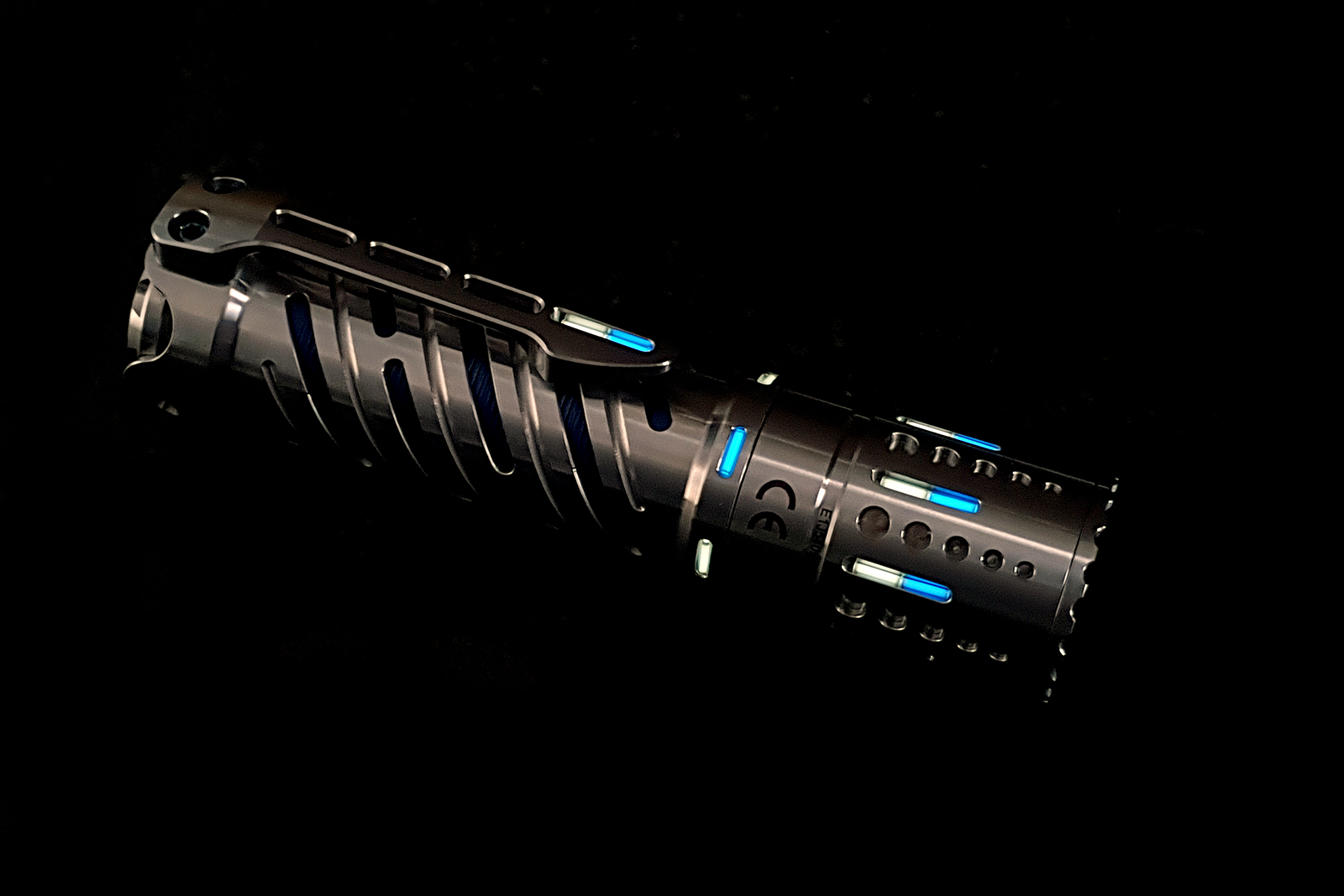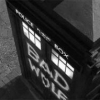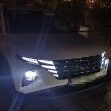Introduction
A little over a month ago, I reviewed the Acebeam E70-AL 6500K and was impressed by its quality and performance. Being quite fond both of Titanium and of high CRI emitters, I could not resist testing the CRI95+ variant of the E70 in a Titanium host.
Acebeam offers two finishes for their Acebeam E70-TI, a stonewashed finish and a PVD coated finish in rainbow colours.


Titanium is a fantastic metal, being very strong and hard for its weight, but it is far from optimal for torches because of its poor thermal conductivity. That, coupled with the high CRI emitter, which by default has low efficiency and produces much more heat than the Cree XHP70.2, means that if you are after performance you would be much better off sticking to the Acebeam E70-AL 6500K.
The Acebeam E70-TI CRI95+ is not about performance, it is about eye candy! The high CRI emitter offers a pleasant tint and excellent colour rendition that compliments the luxurious look and feeling of the Titanium host perfectly.
So, Lumen hunters, that's your cue to exit. Tint snobs, high CRI lovers, Titanium devotees, follow me!
Unboxing
The Acebeam E70-TI CRI95+ comes in a white box with a clear window that allows a view of the light. The box emphasizes the 5 year warranty and the high efficiency, constant current boost circuit, both attesting to the high quality of the Acebeam E70-TI CRI95+.
The back side of the box does not offer any more information on specifications, but rather the company address, a few QR coded links and the usual certification logos.
My Acebeam E70-TI CRI95+ sample is neither the stonewashed nor the PVD coated version. It is a unique sample I procured from Acebeam at a reviewer's discount and it is Chromium Electroplated Titanium. And it is gorgeous!


The top and bottom of the box have nothing printed on them, so nothing to show. One of the longer sides lists the possible applications of the torch while the other shows if the battery is included, the emitter type and a warning regarding safe usage.
Regarding the emitter choice, there is 6500K, 5000K and the 95+ CRI 4500K LED that is featured in today's sample. The 6500K and 5000K are 6V Cree XHP 70.2 LEDs while the 95+ CRI 4500K is the GT-FC40 which is a 12V LED and comes with a different driver.
The maximum output of the CRI95+ emitter is rated at 2500 Lumen, the 6500K at 4600 Lumen and the 5000K 10% less (according to a company representative).


The box features magnetic closure and opens like a book to reveal its contents.

The accessories include a charging cable, 2 spare O-rings, a storage bag and a lanyard, not pictured here as it came attached to the light. The leaflets include the manual, a warranty card, safety instructions and a note explaining the battery is in the light and the insulation sheet needs to be removed before use.

The Acebeam E70-TI CRI95+ comes with the lanyard pre-attached.

I removed the lanyard to better show the torch, which features a unique design that is very harmonious and pleasing to the eye.


The bezel is crenulated and the head features alternating circular and oblong designs, which work well together.

The 8 oblong grooves are meant to house 12x2mm tritium vials according to Acebeam, but are not deep enough to completely cover them, measuring only 1.60mm in depth. As the glass tritium vials are very fragile, protruding equals a 100% chance of breaking. I would suggest to Acebeam to either make the grooves deeper by 0.5mm or, if not possible, to not advertise them as fit to house 12x2mm tritium vials.

The body of the torch features a helix design, with cut outs revealing the inner tube and creating a beautiful visual effect. It also features 6 oblong grooves where it connects to the head that are meant to house 6x1.5mm tritium vials and are perfectly sized for it.


The tail part of the tube features tapped holes where the milled clip comes pre-attached. The clip features an oblong groove that fits a 12x2mm tritium vial perfectly and is deep enough for it.


There are 3 sections at the back end of the body. One with the clip installed, one with tapped holes, where the clip could be moved to - no idea why though - and one with bigger holes, where the lanyard came pre-installed.
Removing the lanyard is very easy but re-installing it requires thin tweezers, which is probably why the company opted to ship the light with the lanyard already installed.


In total, the Acebeam E70-TI CRI95+ features an intricate design which looks quite busy but still harmonious and pleasing to the eye. The machining of such a design is not an easy feat, especially in Titanium and with the level of detail and quality we see here.

The business end of the torch comes with a protective plastic film, which must be removed before use.
Under the protective film, we can see the shallow orange peel reflector and the GT-FC40 CRI95+ 4500K emitter. The combination of such a large LED with the shallow OP reflector guarantee a very floody beam.



The back end of the torch is quite simple. It is where the switch for the operation of the torch is located. I like the simple, recessed design of the switch which allows the torch to tail stand and helps to protect from accidental activation. Clicking the switch is both easy and satisfying, without too much resistance but with adequate feedback.
The web address of the company is printed around the switch, which I find unnecessary and deducting from the aesthetics of the light. I do not mind the name of the light and the hot warning symbol printed at the front, but I would also prefer it if the CE and crossed out bin symbols were omitted.

The head and body unscrew to reveal that the battery ships inside the light, with the positive terminal insulated for safety. The threads are thick and square cut and, on my sample, rather gritty.


The battery is an Acebeam branded 21700 Li-Ion battery, rated at 5100mAh and it features a USB C port near the positive terminal.


Both battery contacts feature thick, good quality springs. These are probably adequate, but I would have still liked to see double springs or spring bypass wires in such a powerful light, to reduce the resistance even further. This would not have changed the brightness, as the Acebeam E70-TI CRI95+ features a boost driver, but could have helped a little with efficiency and run times.
As mentioned before, there is an inner tube, as the light features an electronic switch at the back and both the negative terminal of the battery and the switch need to be connected to the driver. On the driver end, the body contacts the outer tube and connects to the battery negative and the two gold plated contacts near the perimeter connect to the inner tube and transfer the switch presses. The spring in the middle of the driver makes direct contact with the positive terminal of the battery.
Having springs on both ends makes the torch resilient to bumps and drops, as the battery is suspended between two springs under pressure and is not likely to momentarily disconnect and turn the light off.

Quality
The machining quality of the Acebeam E70-TI CRI95+ is very high. Even at close inspection, there are no flaws.
No edge is sharp, not a single spot less than perfectly milled. This is indeed a top quality light.


On very close inspection, the Chrome Electroplating is not as perfect as the milling, with some hairline marks present and the Chrome Electroplating not quite reaching inside the grooves, but as the production torches are either stonewashed or PVD coated, that will not be an issue there.


Specifications
The specifications of the Acebeam E70-TI CRI95+ are not clearly listed on the company's website but I was able to gather them and they can be seen in the following table:

Of course, the Chrome Electroplating finish is just for my sample. The commercially available finishes are, as mentioned before, stonewashed and PVD coated.
I weighed the Acebeam E70-TI CRI95+ at 138g without the battery and 218g with it.
The GT-FC40 emitter has a CCT of 4500K and a CRI of 95+ while it also features high R9 (rendition of the colour red, which is rare even among high CRI emitters). Acebeam claims the Acebeam E70-TI CRI95+ can achieve a maximum brightness of 2500 Lumen.
User Interface
The user interface of the Acebeam E70-TI CRI95+ is simple and intuitive.

Despite featuring a recessed button, and a lock mode, a double click is required to turn the light on. This prevents accidental activation of unlocked lights and protects even the most careless of users from accidental activations, which would be disastrous with such a powerful light.
The user interface of the Acebeam E70-TI CRI95+ is as follows:
-
From Off
- Double click to turn on (with memory for the 4 main modes), click again to turn off.
- Click and hold from off to turn on at Moonlight mode. Keep holding until if flashes three times to lock the light. Click and hold again to unlock into Moonlight mode.
- Triple click for Strobe. Click to turn off or double click for Turbo.
-
From On
- Click to turn off.
- Hold to cycle through the main modes (Low, Mid1 ,Mid2, High).
- Double click for Turbo. Double click again to return to previous mode.
- Triple click for Strobe. Click to turn off or double click for Turbo. From Turbo, click to return to previous (before Strobe) mode. There is no way to go directly from Strobe to a previous, non Turbo mode.

Acebeam does not provide the output ratings of each mode, but I measured them for you and you can see the actual numbers in the table below. Notice that the Turbo output slightly exceeds the specifications. Unfortunately, my equipment is unable to measure the brightness of the Strobe mode.

Beam-shots
The beam pattern of the Acebeam E70-TI CRI95+ is exactly what can be expected from a large emitter combined with a shallow, orange peel reflector. The light is very floody, with a large hot spot and a lot of spill.
Compared to the Acebeam E70-AL 6500K with the domed Cree XHP70.2 emitter, the Acebeam E70-TI CRI95+ with the flat GT-FC40, has a bit more throw per Lumen and a tighter hot spot.


I tested the Acebeam E70-TI CRI95+ outside, over a distance of 70m.

The following video shows a comparison of the Acebeam E70-TI CRI95+ with the Acebeam E70-AL 6500K and the Fireflies E07 (with 7 Nichia 219b sw45k emitters).
Driver
The driver of the Acebeam E70-TI CRI95+ is a digitally regulated, constant current boost driver, which should be able to maintain constant brightness regardless of the battery voltage and also features smart temperature control, reverse polarity protection and low voltage protection. Very refreshing to see such a high quality driver.
There is no PWM in any of the modes.


Tint and Size Comparison
The tint of the Acebeam E70-TI CRI95+ is a neutral - warm 4500K and seems to be slightly below BBL. This light is a joy to behold, provides excellent colour rendition (including red) and is very pleasing to the eye.
In the comparison photo below, you can see the neutral - pink tint of the Acebeam E70-TI CRI95+ in the middle, compared to the green tint of the Acebeam E70-AL 6500K on the left and the rosier tint of the Fireflies E07 (with Nichia 219b sw45k emitters) on the right.

The above photo also offers a size comparison between the lights. The Acebeam E70-TI CRI95+ is not a light that can be easily carried in your trousers pocket, but it fits fine in a winter jacket or a backpack.
Battery and Charging
The battery included with the Acebeam E70-TI CRI95+ is a 21700, rated at 5100mAh and features onboard USB C charging.


The specifications of the Acebeam IMR21700NP-510A with Built-in USB C Port, as shown on the company's website, are listed in the following table:

I measured the capacity of the battery at exactly 4716mAh which is rather low compared to its 5100mAh rated capacity. The battery's internal resistance was measured at 26mΩ. The light has Low Voltage Protection and turns off when the battery voltage drops to 2.8V.
Charging the Acebeam IMR21700NP-510A with Built-in USB C Port is very easy. Just connect the provided cable or any other USB C cable to the charging port and its other end to a charger. Both USB A to USB C and USB C to USB C cables can be used as well as any charger, including the ones that support PD. This is very convenient as you can charge the Acebeam IMR21700NP-510A with Built-in USB C Port with any USB C cable and charger you have at hand. The LED on the battery lights up red to indicate that it is charging and turns green when the charging is completed, at 4.14V.


The Acebeam IMR21700NP-510A with Built-in USB C Port took 6 hours, 22 minutes and 27 seconds to charge from 2.8V to 4.14V. The maximum current drawn was 0.899A, which is low for a 21700 battery and explains the very long charging time. A charging circuit which can support 2A charging would have been much better.
As the specifications indicate that the standard charging current is 1A, I can't help but wonder if it would be OK to charge the battery at 2A through a charger with large enough cradles to fit a protected button top 21700.

A very nice feature of the Acebeam IMR21700NP-510A with Built-in USB C Port is its ability to function as a power bank. This is facilitated by the USB A port on the included charging cable, but a USB C to USB C cable can also be used, even for devices that do not support power delivery.
When the Acebeam IMR21700NP-510A with Built-in USB C Port is functioning as a power bank, its indicative LED turns blue.


There is no information available regarding the current the battery can provide through its USB C port so I had to investigate. Anything above 2.7A and the circuit would immediately reset. I gradually reduced the current until I found it to be initially stable at 2A, which is a good output. Unfortunately, this only worked with a fully charged battery and after 40 minutes of drawing 2A, the circuit started resetting. At the end of the test, and after countless resets, the battery voltage was 3.14V.

I tempered my expectations and tried drawing 1A from the battery and this seems to be the maximum supported current for the power bank function, as the battery was able to maintain it with stability for 3 hours, before the circuit reset a few times and then turned off. I would have much preferred it if it had turned off without the resets, as I am not sure if they could damage any sensitive equipment being charged. The battery voltage at the end of the test was 2.99V.

The Acebeam IMR21700NP-510A with Built-in USB C Port is a battery packed with nice features such as onboard USB C charging and power bank functionality, along with a large 5100mAh capacity. Nevertheless, the actual capacity of 4716mAh and the slow charging speed leave something to be desired, especially considering the $23.90 price tag.
EDC Bulb
Acebeam offers an accessory which adds a lot of value to the Acebeam IMR21700NP-510A with Built-in USB C Port. It is the Acebeam EDC Bulb.

The Acebeam EDC Bulb attaches to the top of the Acebeam IMR21700NP-510A with Built-in USB C Port and connects to the battery's USB C port to draw power.
The installation and operation are explained in the animation below.

The specifications of the Acebeam EDC Bulb as found on the company's website, are in the following table:

This tiny plastic attachment adds a lot of functionality to the Acebeam E70-TI CRI95+ and is a must buy, especially since it normally costs only $3.99 and is currently on offer for a mere $0.10. Unfortunately, it is also out of stock.
The modes that the Acebeam EDC Bulb supports, along with their respective run times, are listed in the table below:

The Acebeam EDC Bulb is so simple and at the same time so useful and nicely implemented! It really adds value to the Acebeam IMR21700NP-510A with Built-in USB C Port.


Current Draw
The Acebeam E70-TI CRI95+ has a low parasitic drain that is below the ability of my clamp meter to measure. The Moonlight mode draws 129mA. The Low, Mid1, Mid2 and High modes need 302mA, 565mA, 1.295A and 2.167A respectively and Turbo requires 10.64A.


If we compare those values to the ones we got from the Acebeam E70-AL 6500K we can clearly see how much efficiency is lost. This translates to less light and more heat. It is the price we pay for high quality light.
Here is a comparative table showing the measured light output versus the current draw. This allows us to calculate the efficiency of each mode in both torches.

As we can see the efficiency of the Acebeam E70-TI CRI95+ is much lower.

Output & Runtimes
The Acebeam E70-TI CRI95+ with the 4500K GT-FC40 CRI95+ emitter is rated at a maximum of 2500 Lumen. Acebeam does not declare its maximum throw.
I do not own a multi thousand dollar worth integrating sphere, just a logging Lumen meter and a home made integrating tube. The array is calibrated with 3 separate, professionally measured lights and gives me consistent results, but there is definitely room for error and deviations are to be expected.
According to my measurements, the maximum output (at turn on) was 2564 Lumen, which slightly exceeds the declared 2500 Lumen. ANSI output (at 30 seconds) was 2288 Lumen and the rapid output decline continued down to 896 Lumen at 1 minute and 12 seconds. It then declined gradually as the temperatures rose, to 840 Lumen over the next 1 hour, 29 minutes and 28 seconds. After that, it stepped down to Mid1 level for 2 minutes and 39 seconds and then dropped to Low level for a further 19 minutes and 2 seconds, before it turned off.
While the output of the Acebeam E70-TI CRI95+ is good for its size and taking into account that it is using a very high CRI emitter, the low efficiency of that emitter along with the Titanium construction cause some extremely high temperatures to develop. The head of the torch exceeded 90°C! The body is somewhat protected because Titanium does not conduct heat well, but still reached over 60°C during the test. This is definitely not a light to hold in bare hands on Turbo for extended periods of time.

The following graph shows the first 10 minutes of the Runtime Graph in greater detail.

I also ran the test on High output. Thermals were more manageable this time as output was reduced. The body stayed below 55°C and the light output was stable and lasted for 2 hours, 10 minutes and 37 seconds on High, before it turned off.

The following graph shows the first 10 minutes of the High Runtime Graph in greater detail.

The light quality of the Acebeam E70-TI CRI95+ is really impressive and so is the premium feeling of the Titanium body, but efficiency suffers for it and thermals are a definite consideration. The torch is very usable, despite the low efficiency and high temperatures and I actually prefer it and use it much more than the Acebeam E70-AL 6500K because of the significantly better quality of the light it produces
Acebeam does not specify the maximum intensity and throw of the Acebeam E70-TI CRI95+. I measured the maximum intensity to be 8932cd and the maximum throw at 183m.
Acebeam E70-TI CRI95+ vs. Acebeam E70-AL 6500K
The following graph compares the output and thermal performance of the Acebeam E70-TI CRI95+ to those of the Acebeam E70-AL 6500K.
As expected, the Acebeam E70-TI CRI95+ has both lower output and less run time, while the temperatures are much higher. Notice the higher difference between head and body temperatures in the Titanium host versus the Aluminium host, which is indicative of the bad thermal conductivity of Titanium.

The following graph shows the first 10 minutes of the comparison, in greater detail. For the first 10 minutes, the Titanium body is even more comfortable to hold than the Aluminium.

It goes without saying that an Aluminium host and a high efficiency emitter win in performance. The high CRI emitter and Titanium host win in light quality and premium feeling. The choice is yours to make.
Conclusion
The Acebeam E70-TI CRI95+ is a light that emphasizes quality.
The machining of the Titanium host is intricate with no imperfections or sharp edges. The driver is fully regulated and provides constant current output without any PWM on any of the modes. The GT-FW40 CRI95+ 4500K emitter is below the BBL and produces a very pleasant beam with fantastic colour rendition.
The User Interface is simple and functional and extra care has been taken to prevent accidental activations.
The size is normal for a 21700 light and not too easy to fit into trousers pockets, although not impossible. I would prefer to carry the Acebeam E70-TI CRI95+ in my backpack or in the pocket of a winter jacket. Or a holster, which should have been included.
The optional Acebeam IMR21700NP-510A with Built-in USB C Port battery features USB C onboard charging and Power Bank functionality while the Acebeam EDC Bulb optional accessory adds a lot of usability and value.

If you are looking for a premium quality torch that feels luxurious to hold and produces light equally as luxurious to look at, then the Acebeam E70-TI CRI95+ is a light you should consider. If you prefer efficiency and high output, then look at the Acebeam E70-AL 6500K instead.
The Acebeam E70-TI CRI95+ can be purchased directly from the company's website and the cost at the moment this review is written is $208.80, including the battery and shipping, worldwide. The light without the battery costs $188.90, but keep in mind that only button top protected 21700 batteries that can provide at least 10.64A of current will work.
Let's list the Pros and Cons of the Acebeam E70-TI CRI95+:

Pros
+ Below BBL CRI95+ 4500K emitter produces excellent light quality.
+ Digitally regulated constant current boost driver which provides stable output and high efficiency with no PWM.
+ Luxurious Titanium Body construction.
+ Long runtimes.
+ Impeccable and intricate machining.
+ USB type C charging integrated in the battery.
+ Low Voltage Protection.
+ Quality springs on both sides of the battery.
+ Smart ITS Temperature Control.
+ Simple and intuitive UI.
+ 6 slots for 6x1.5mm tritium vials.
+ IP68.
+ The battery provides Power Bank functionality.
+ The Acebeam EDC Bulb optional accessory is very useful.

Cons
- Bad thermal performance.
- Low efficiency.
- The 8 slots on the head meant to house 12x2mm tritium vials are only 1.60mm deep and cannot protect the fragile glass vials so are not fit for purpose.
- The battery is expensive.
- The battery takes a long time to charge.
- Actual battery capacity is 4716mAh instead of 5100mAh.
- A holster should be included.
Thanks to Acebeam for providing a reviewer's discount for the light for review

Polymeros Achaniotis 28/09/2021
-
 6
6












Recommended Comments
There are no comments to display.
Create an account or sign in to comment
You need to be a member in order to leave a comment
Create an account
Sign up for a new account in our community. It's easy!
Register a new accountSign in
Already have an account? Sign in here.
Sign In Now